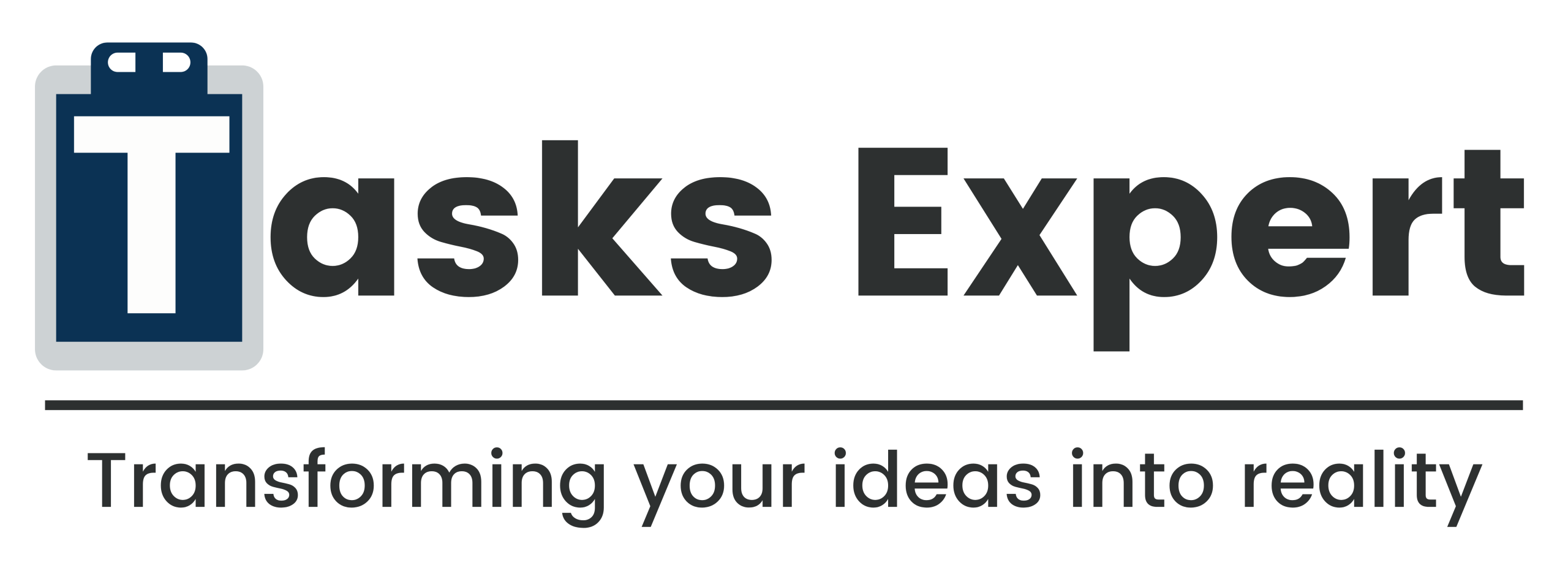Introduction
You’ve heard it before: backlinks still matter.
But in 2025, it’s not about blasting hundreds of emails or joining spammy directories. It’s about smart link acquisition; earning relevant, high-authority backlinks that improve your search rankings and drive qualified traffic.
In this guide, we’re cutting through the noise and focusing on what works. SEO pros, growth marketers, and content teams that understand how to win in a competitive space use these link acquisition techniques.
Why Link Acquisition Still Matters
Even with ongoing updates in search algorithms and online trends, there is one thing that holds true in SEO: backlinks are still important. A quality backlink is a vote of confidence from one website to another. When a reputable site links to your page, it’s giving search engines, particularly Google, the nudge that your page is something worth paying attention to.

Link Acquisition help develop authority, credibility, and relevancy. They are some of the most powerful ranking factors as they prove that you have other sites trusting your content. It’s one of the most important factors in where you show up on the search engine results page (SERP). For example, if 2 pages are both the same in on-page SEO but one has better backlinks, this page will often rank higher than the other.
But not all links are created equally. A single do-follow link from an extremely authoritative high-traffic website may be worth more than dozens or even hundreds of low-quality links from spam or irrelevant sites. Building too many low-quality links is harmful, it could lead to penalties or a reduction in trust for a site from search engines.
It’s no longer the total amount of links; it’s the quality of links and how they fit the context.
In brief, link acquisition is not an SEO trick—it’s a long-term brand-building strategy. If organic growth matters to you, it’s something you can not afford to overlook.
Build Authority Assets
If high-authority sites are to link to you, provide them something to link to. Authority assets are content items built to be worthy of reference, not theoretically so, but practically so.
These are resources that others naturally want to cite in their content. Think about how often you’ve linked to a source that had better data, better clarity, or better tools than your own. That’s the goal here: create something so useful, people want to reference it.

What Works:
1. Primary research or industry statistics:
Conduct surveys, gather statistics, or examine trends within your space. Even a small set of data—if it’s original and relevant—can garner links from analysts, bloggers, and journalists. Example: A SaaS firm surveys 500 users regarding onboarding experiences and releases the results with charts. That’s linkable gold.
2. Definitive guides or explainers:
Material that fully addresses a topic becomes the standard source for others who write about the same topic. Strive to produce 10x content—something much more complete, current, or graphical than what’s currently ranking. These guides will naturally gain links over time.
3. Templates, toolkits, or calculators:
Things that save people time are popular. If you build something like a budget calculator, SEO checklist, or editable pitch deck, it’s probably going to be shared and referenced in tutorials, blogs, and newsletters.
Pro Tip: Don’t make your asset hidden behind complicated menus. Make it quick to find, quick to share, and quick to quote. Include an embed feature or ready-to-go HTML snippet so that others can quote it neatly. Share your asset on LinkedIn, in specialized forums, or by influencers to optimize reach and links.
Also Read: Virtual Assistant Services in Mosta
Leverage Digital PR
Digital PR is among the strongest, underleveraged link acquisition techniques when implemented properly. It’s not spamming journalists with generic press releases or blasting media types. It’s about receiving rightful attention for something timely, unique, or useful, and then leveraging that attention into backlinks.
When your perspectives, product, or ideas are featured by media sites or leading blogs, they typically provide a link, oftentimes from authoritative domains. This establishes credibility for users and search engines alike.
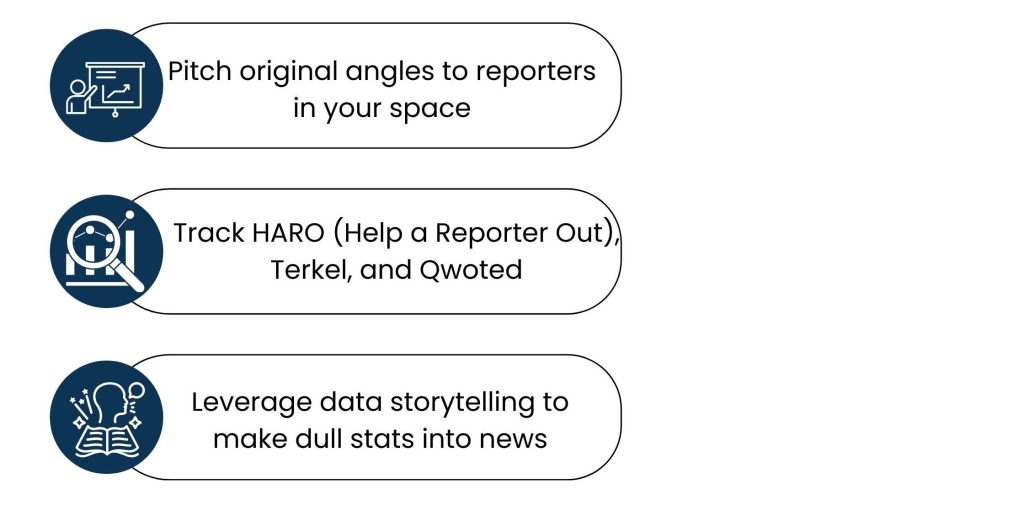
How to Do It:
1. Pitch original angles to reporters in your space:
Read what they’ve published previously and discover something new. Pitch the story, not your business. Reporters must produce content daily, and if you assist them in doing so with something new, they’ll link back to your site.
2. Track HARO (Help a Reporter Out), Terkel, and Quoted:
These sites put you in touch with reporters currently searching for expert sources. Consistent responses can get you links on news websites, magazines, and major blogs. Your response needs to be concise, credible, and clear.
3. Leverage data storytelling to make dull stats into news:
Don’t write “25% of marketers use AI.” Write, “1 in 4 marketers are counting on AI to replace copywriters by 2027.” Craft stories that are headline-worthy and newsworthy. Journalists adore new data with a hook.
Bonus Tip: When your content is referenced, follow up to make sure the link is do-follow and contains the proper URL. With time, a few earned media placements can generate hundreds of backlinks through content sharing, scraping, and secondhand mentions.
Link Reclamation
Link recovery is possibly the most effective and underappreciated means of Link acquisition. It’s a matter of discovering where your product, brand, or content has been spoken about already on the web, yet the publisher didn’t make it backlinked. That’s low-hanging fruit.
These mentions are worth something because they’re already warm—someone wanted you enough to mention your name. The only thing lacking is the link, and with a courteous, timely email, that gap can usually be filled without much difficulty.

1. Find unlinked brand mentions:
Use tools like Google Alerts, Ahrefs Content Explorer, Brand24, or Mention.com to monitor where your brand name or product appears online. You’ll quickly build a list of potential opportunities.
2. Evaluate the mention:
Before reaching out, make sure the mention is favorable and relevant. If it’s in a negative context or a low-authority site, skip it. Focus on those that reflect positively on your brand and come from credible domains.
3. Send a concise email:
Something like: “Hi [Name], thanks for mentioning [Brand/Content Name] in your article!
Would you be willing to link to our original page here: [URL]? It will make it easier for your readers to find the source. Appreciate the shout-out!
This is short and polite. If they agree, you’ve just earned a natural, high-relevance backlink without creating new content.
Pro Tip: Review this process every quarter. New mentions appear all the time, particularly if your PR or marketing is picking up steam. It’s one of the easiest methods for keeping robust link equity throughout the web.
Broken Link Building
Broken link building is an old-school method that still holds up, because it addresses a genuine issue for webmasters. All sites inevitably collect dead links. Broken links damage user experience and SEO, so owners of sites typically welcome the opportunity to replace them, particularly if you offer a high-quality alternative.
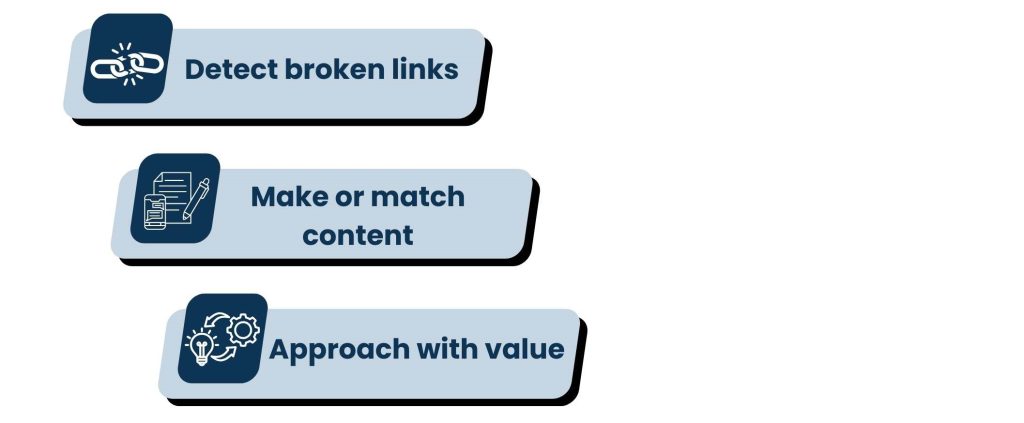
Why It Works:
You’re not requesting an undeserved favor. You’re assisting someone in tidying up their website. By indicating a broken link and proposing a substitute that brings value, you’re establishing a win-win situation.
1. Detect broken links:
Utilize tools such as Ahrefs Broken Link Checker, Screaming Frog, or Check My Links (Chrome extension) to crawl competitor or niche sites for broken external links. Target blogs, resource sites, or link roundups.
2. Make or match content:
If the dead link was referencing a kind of content you already possess (or could readily replicate), utilize that as your substitute. For instance, if the dead link was pointing to a guide on “remote team management,” and you have produced a comparable guide, you’re golden.
3. Approach with value:
Here’s how you could craft the message: “Hi [Name], I caught a dead link on your site [URL]—it’s pointing to [Dead Page]. I figured you’d like to replace it. I have another resource that works similarly: [Your Link]. Hope it’ll keep your readers up to speed!”
Let the tone be helpful, rather than sales-like. You’re providing a solution, not attempting to promote.
Pro Tip: Begin with sites you already have a connection with—partners, peers, or smaller publications. Once you’ve perfected your method, expand it to larger domains in your niche.
Use Strategic Partnerships
Strategic partnerships aren’t solely about co-marketing—they’re a treasure trove of natural, high-quality backlinks. By partnering with another brand, business, or idea leader, links occur naturally in the process.
These aren’t spammy link reciprocals. They’re natural mentions that happen during value exchanges of mutual value, such as content co-creation, events, and joint campaigns.
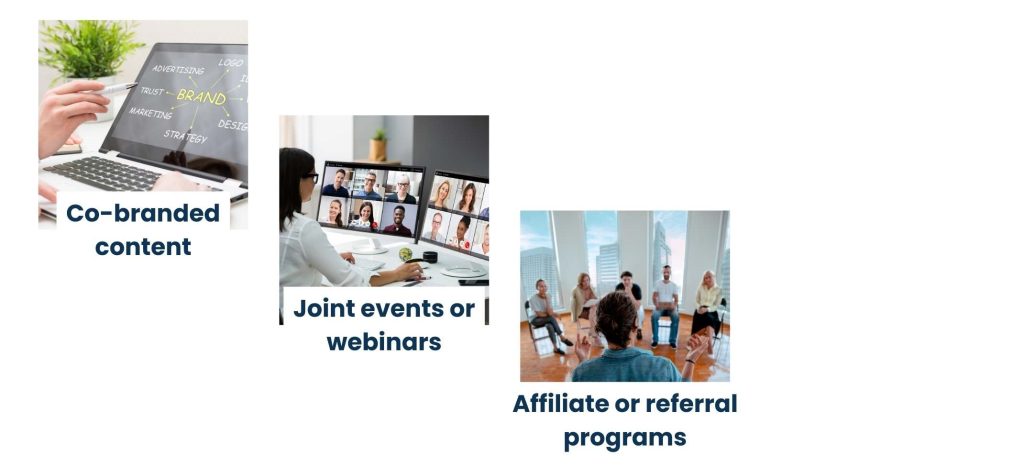
Link Opportunity Examples:
1. Co-branded content:
Develop a joint guide, eBook, or blog post with a partner business. Both of you publish on each of your respective sites and link to each other. This introduces both brands to new audiences and creates a solid link authority.
2. Joint events or webinars:
Run an event or training session together. You’ll create landing pages, announcements, and recap content—all great opportunities for links.
3. Affiliate or referral programs:
These naturally generate backlinks from trusted partners, often within contextually rich content.
How to Get Started:
- Identify businesses in your niche that complement, not compete.
- Reach out with a collaboration idea that benefits both sides.
- Design the engagement so that link opportunities arise naturally through content, promo pages, or blog features.
Pro Tip: Try link acquisition from evergreen content during these collaborations—something that will remain live (and continue to provide backlinks) well after the campaign is over.
Refresh and Promote Old Content
SEO isn’t necessarily about writing more—it’s about doing more with what you already have. One of the most underutilized link acquisition strategies is refreshing old posts and re-releasing them with new value.
Why recreate the wheel when your older posts have already established some traction, backlinks, or engagement? By revamping them, you make them more desirable to link to—again.
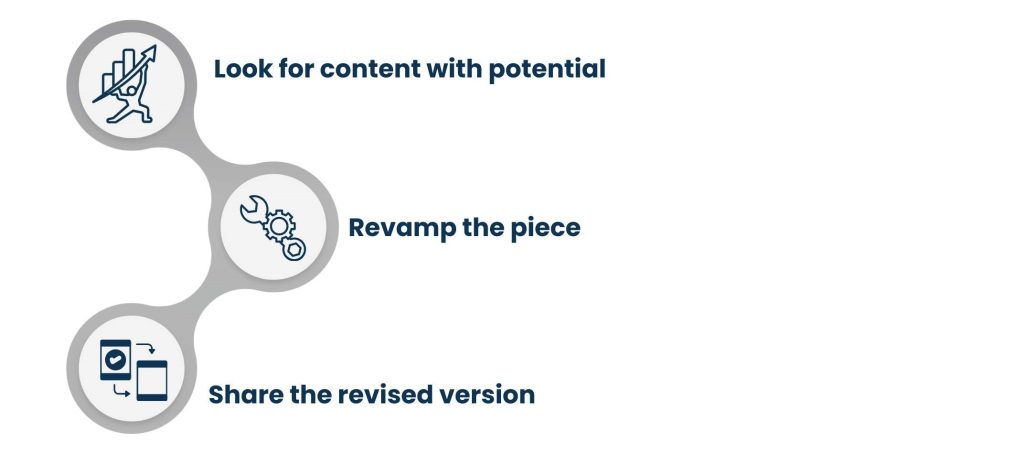
How to Do It:
1. Look for content with potential:
Use Google Search Console or Ahrefs to identify blog posts ranking on page 2 or with backlinks but waning traffic. These are the best candidates.
2. Revamp the piece:
Update statistics, examples, images, and internal links. Replace outdated information, rewrite the introduction, and refine formatting. Even minor changes can have a drastic effect on shareability.
3. Share the revised version:
Email individuals who shared it previously: “Hi, just a heads-up that we’ve revised our [Topic] guide with new findings for 2025. Maybe worth sharing again or updating—here’s the revised link.”
Post in communities, newsletters, or to collaborators who may have missed it initially.
Why It Works: You’re offering something new and proven. Google favors freshness, and site owners are more likely to link to updated resources than outdated ones. This approach compounds value—your past content keeps earning returns.
Get Listed in Resource Pages
One of the easiest and most evergreen ways to build high-quality backlinks is to get your site or content listed on resource pages. These are curated collections of helpful tools, services, or links related to a specific topic—often hosted on .edu, .org, or authority blog domains.
Because these pages exist specifically to link out, you’re not interrupting—you’re providing value.
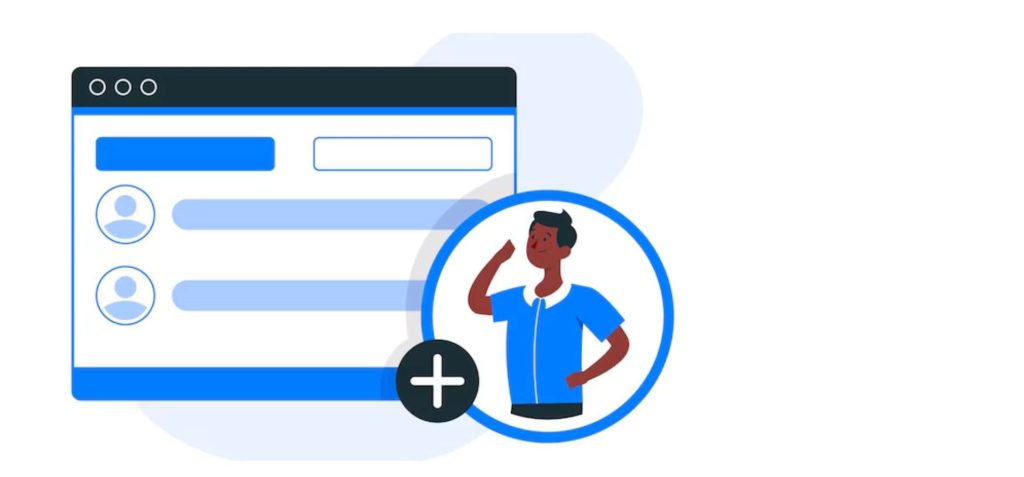
How to Find Opportunities:
Utilize search operators such as:
- Intitle: resources + [your keyword]
- Inurl:links + [your niche]
- Site:.edu + [your topic] + resources
These queries will show pages that are actively curating helpful content. For instance, if you are selling HR software, search for “best HR tools” or “remote work resources.”
How to Pitch:
After you locate a suitable page, read it thoroughly. Ensure your content belongs to the theme—do not push it. Then email with a straightforward message:
“Hi [Name], I saw your terrific list of [topic] resources. I’ve just released a [tool, guide, or template] that might be a perfect addition to your audience. Here’s the link: [URL]. Hope to be eligible—best regards for your time!”
Why This Works: Owners of resource pages are constantly seeking to refresh and maintain their lists. If your content contributes something valuable, it’s typically a fast “yes.” Such backlinks are typically high-authority, topical, and long-term.
Bonus Tip: After you’ve been listed, help promote the page on which you’ve been listed. That boosts its visibility (and SEO authority), which helps your backlink even further.
Also Read: Virtual Assistant Services in Birkirkara
Make Content Curation-Friendly
Some content is inherently more linkable because it saves others’ effort, time, or research. These pieces of content become “linkable content”—i.e., people link to them when they are producing their articles, guides, or roundups.
By creating content with curators, bloggers, and teachers in mind, you significantly improve its chances of getting backlinks over time.

What to Create:
1. Stats roundups:
Put fresh figures from credible sources together in one location. Ensure every stat is referenced and sorted by category. Example: “Top 50 Remote Work Stats for 2025.”
2. “Best of” or tools lists:
Individuals love lists of tools, books, podcasts, or platforms curated just for them. Make them simple to scan and provide summaries or comparisons.
3. Templates, checklists, and frameworks:
Actionable tools such as downloadable checklists, email templates, or step-by-step systems are very linkable since they offer direct usefulness.
4. Embeddable visuals or infographics:
Create visual content that other people can reuse within their posts with a link to your site. Add an embed code underneath the image to make it simple.
Promotion Strategy:
When published, distribute your content to applicable online communities (such as Reddit, Slack channels, or industry forums). Offer to newsletter curators or journalists seeking fresh sources to cite.
Why It Works: By assisting others in finishing their content, you become integral to their process. It is an authoritative position that creates steady backlinks over the long term.
Convert Podcast Interviews into Links
Podcasts are a burgeoning content stream—and they’re a link-building treasure trove, too, when done strategically. Each time you guest on a podcast, you get to build a backlink from the show notes, the host site, or the promo material they promote.
The secret is to leverage podcast guesting as part of your SEO and PR strategy, rather than simply a branding exercise.
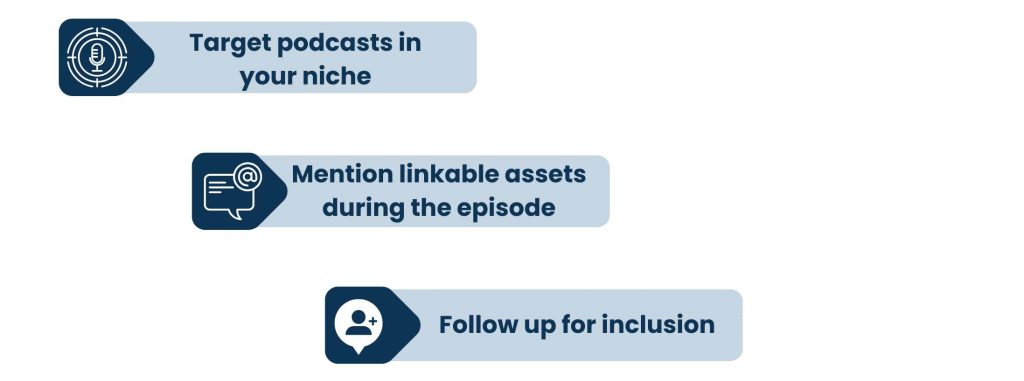
How to Make It Work:
1. Target podcasts in your niche:
Focus on shows related to your area of expertise and audience. Even smaller podcasts may have good SEO value if the sites have high authority or traffic.
2. Mention linkable assets during the episode:
Discuss a free tool, checklist, blog post, or research you’ve developed. Keep it relevant to the subject so it sounds natural, and include the exact URL.
3. Follow up for inclusion:
After the show has aired, email the host (or producer) and politely request that your resources be linked in the show notes. Most are more than happy to comply.
Why This Matters: Most podcast sites have a specific episode page with backlinks to the guest’s site, social media profiles, and resources. These are relevant backlinks, which are usually from authoritative domains. Some podcasts get syndicated to several places, tripling your visibility.
Bonus: You also have credibility, referral traffic, and brand recognition, added to SEO benefits. Unlike cold emailing, these backlinks are from a real conversation and value exchange.
Conclusion
The era of buying links in bulk or spammy comment links is over. If you desire results, your link acquisition techniques must be strategic, innovative, and value-driven, not volume-driven.
The methods mentioned above don’t work based on tricks—they work based on relevance, relationships, and quality content. That’s why they continue to work.
Look at what you’re already doing, and ask: “Which of these strategies could we implement in the next 30 days?”
Begin there. Create momentum. And see your rankings (and traffic) begin to reflect the effort.
If you’re seeking hands-on assistance with creating an organic link acquisition strategy specific to your business, Tasks Expert can connect you with the right specialists to make it happen.
About Us
Tasks Expert offers top-tier virtual assistant services from highly skilled professionals based in India. Our VAs handle a wide range of tasks, from part time personal assistant to specialized services like remote it support services, professional bookkeeping service etc. Furthermore, it helps businesses worldwide streamline operations and boost productivity.
Ready to elevate your business? Book a Call and let Tasks Expert take care of the rest.




